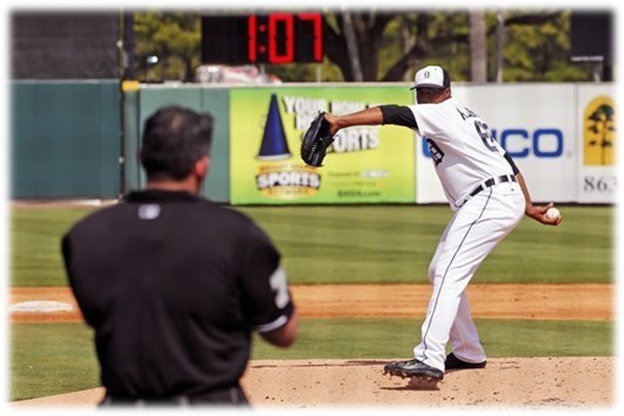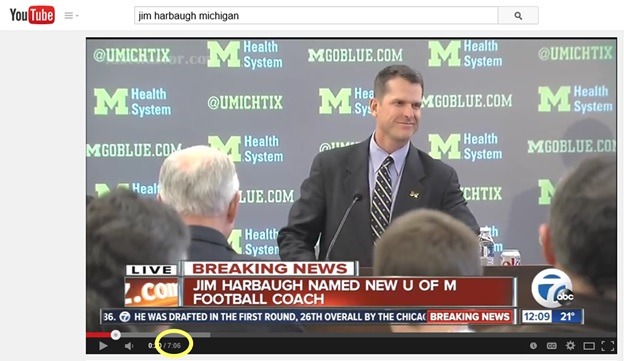I’m sitting at a Tigers vs. Marlins exhibition baseball game earlier this month, and after the Tigers made three easy outs in a row (this was a disturbing pattern, by the way), I couldn’t help but notice that straight out in centerfield was a digital clock – almost like an egg timer – counting down two minutes.
That’s the time that umpires and the two teams have in between half innings to reassemble, do their warm-up pitches, practice swings, throw the ball around, and get the game moving again. While it is much debated whether there should be a clock of any kind in baseball, MLB is trying hard to remedy the expanding length of its games. The average duration is more than three hours, which goes against the grain of our shortening-attention-span brains.
Like any major institution or brand that depends on consumer spending and participation, the MLB corporate types know that fans continue to push back at the leisurely pace of games, especially over a long 162 game regular season, plus Spring Training, plus Playoffs and perhaps the World Series. Their research must be consistent with what everyone else is seeing. What were once easygoing afternoons at the old ballpark have instead become slow-paced marathons punctuated by fans arriving late, leaving early, and seemingly checking their phones nonstop.
If you think about it, time continues to be a major factor in the ways in which we consume entertainment and informational content – especially online. And even though the Internet is essentially infinite, the patience level of consumers continues to shrink almost in reverse proportion to the number of options we have. It’s as if that digital timer has been embedded into our brains, making us more aware of the passage of time.
At a conference in Germany back in 2011, Google Chairman Eric Schmidt reminded his audience about the promise of Google, the Internet, and smartphones, preaching about a new reality where “You’re never bored.”
The evidence abounds. And maybe it was accelerated by Twitter, the first social media site to put a character limit our posts. At first, everyone made fun of this 140 characters rule, claiming that it was a gimmick. But Twitter taught us about brevity, being concise, and staying on point – all qualities that have come in very handy.
And then came 7-second videos on Vine, and then disappearing photos on Snapchat, all with that same theme: attention spans are shrinking, forcing us to more creative, concise, and quick about our content and communication.
In fact, our brains have become so retrained to think about time – how long, how much, how fast – that we subconsciously calculate our attention spans every time someone sends us a video. Think I’m wrong? The next time there’s a video in front of you, tell me that your eyes don’t wander to the lower section that tells you its duration – perhaps the most important determinant in whether you’ll actually watch it.
And we’re all impacted by content that’s getting shorter, forcing us to make it meatier but sleeker. That’s a big part of why the TED Talks are so successful. Yes, presenters are smart and well-rehearsed. But the talks are just 18 minutes long – and that’s a calculated choice. TED curator Chris Anderson explains why:
“It’s long enough to be serious and short enough to hold people’s attention. It turns out that this length also works incredibly well online. It’s the length of a coffee break. So, you watch a great talk, and forward the link to two or three people. It can go viral, very easily.”
And so the timing of PPM in our radio lives becomes even more salient and important. And while some believe that meters have limited talk breaks, when the content is clean, crisp, and compelling, it doesn’t have to be long. In fact, great bits, callers, and payoffs can and should be streamlined to make them concise, entertaining, memorable, and of course, shareable.
Programmers and jocks in diary markets may think they still have license to go off and do extended breaks, but the fact is the changing rules of shortening attention spans apply to every radio station, whether it’s in Lexington or Los Angeles.
It means “on-ramps” have to be quicker, content’s got to be better, the payoffs need to be great, and the forward momentum needs to be compelling.
As attention spans shrink, the bar gets raised.
(And yes, this post is probably too long.)
- The Exponential Value of Nurturing Radio Superfans - April 28, 2025
- What To Do If Your Radio Station Goes Through A Midlife Crisis - April 25, 2025
- A 2020 Lesson?It Could All Be Gone In A Flash - April 24, 2025






Excellent!!! Next!
The “ON RAMP” Get on the friggin’ “on ramp” ASAP!!!!!
🙂 Eyes in the road, hands in the wheel, young man.
You mentioned the egg timer at the ballpark. As I’m sure you know, Fred, all-time great baseball play-by-play man Red Barber, who started calling games in the 30s, used an egg timer to remind himself to give out the score more often. Every time the sands of the hourglass ran out, he gave the score, and flipped it over. Maybe it’s time for current broadcasters to adopt that same device to streamline talk segments. And if the hourglass is too old school, there’s probably an app for that.